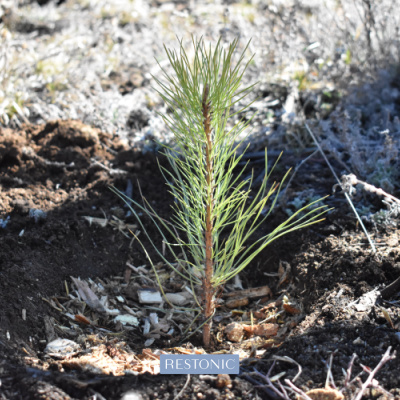 Why bringing out your inner arborist is a really good thing
Why bringing out your inner arborist is a really good thing
Trees are part of our everyday lives, whether we appreciate them on a hike or relaxing nature walk, use them for shade or shelter on a sunny day or enjoy the (literal) fruits of their labor – apples, peaches, plums, nectarines or other tree fruits. Did you know almonds grow on trees? But did you also know that trees serve us in many more ways than providing shade on a sunny day, as material for your favorite flooring or growing your favorite fruit?
Let’s look at 5 key health benefits we all gain from trees on a daily basis.
 1. Trees are super cool – literally
1. Trees are super cool – literally
Have you heard of the net cooling effect? This means that planting trees can help cool the environment surrounding them. For example, a tree planted in your backyard can have the effect of 10 room size air conditioners operating 20 hours a day. Areas without trees become ‘heat islands’ with higher temperatures than those with trees. As well, planting trees around your home can provide shade during the hottest hours of the day, while helping to absorb light energy. According to conservation.org, well-planned landscaping – which includes trees – can help reduce your home’s heating and cooling bills.
So, if you’re looking for another way to sleep cooler, think about planting trees around your house!
2. Trees make us happy
Seems like the tree huggers have it right. Studies show that being around trees can reduce stress and increase feelings of happiness and well-being. Why? Let’s start with the fact that trees are in nature, and we all know that in our busy, tech-obsessed urban lives, breathing in and experiencing nature seems to instantly relax us. In fact, the Japanese practice of forest bathing, which is spending significant time walking and breathing in forest-fresh air, is a form of meditation that can reduce stress and promote overall feelings of inner happiness. The good news – especially for those of us who don’t have forests nearby – is that even looking out a window at trees can lead to improved mental health. And we all know that when we’re less anxious and less stressed we sleep better, which in turn benefits our overall health.
 3. Trees clean the air
3. Trees clean the air
You’ve heard of photosynthesis, right? Greenery (like the leaves on trees) helps clean the air and allows us to breathe better by turning the carbon monoxide in our air into easy-breathing oxygen. In fact, trees can absorb about 48 pounds of carbon dioxide each year, with that number hitting as much as one ton by the time the tree is 40 years old. As well, trees absorb odors from the air and pollutant gasses such as nitrogen oxides, ammonia, sulfur dioxide and ozone. Trees can also filter particulates out of the air by trapping them on their leaves and bark. Thank you for our fresher air, trees!
4. Trees keep us healthy
In addition to providing clean air for us to breathe, and having a positive effect on our mental health, surrounding ourselves with trees can improve our physical health too. Spending time in forests has been shown to improve our immune systems as well as lowering cortisol levels, blood pressure, pulse rates and sympathetic nervous system activity (stress). In turn, when we’re around trees our parasympathetic nervous system activity (relaxation) goes up, all of which is tied to heart health. Plus, a study from 2005 showed that being around green space kept older adults safe from sleep problems as they aged.
 5. Trees keep our environment healthy – in more ways than one
5. Trees keep our environment healthy – in more ways than one
When we think of pollution, we usually think of greenhouse gasses and smog. But did you know that noise pollution can be just as damaging to our peace of mind?. Luckily for us, in addition to preventing soil erosion, helping to keep the air clean and providing shade, trees act as natural noise blockers. In fact, according to a U.S. Department of Energy study, trees and shrubs can reduce human-heard frequency noise levels by up to 50%. Plants absorb sound energy through sound attenuation, which is a dampening of sound that results in the reduction of sound waves in the air. The more surface area of the plant – trunk, leaves, branches – the more sound attenuation it provides, whether it’s deflecting, absorbing, refracting or masking the sound. Now, we know where the old adage ‘if a tree falls in the forest…’ comes from.
6. Fun fact – trees need rest, just like us!
Did you know that trees need their rest, just like us? According to One Tree Planted, while trees don’t sleep in the same way that animals do, they do relax their branches at night-time, which means they have an active/rest rhythm. In fact, researchers found that trees have different circadian rhythms depending on their species. For example, Birch trees drop their branches on average 10 cm per night, and then by just after first light, return them to their original position.
Rest well & wake up ready to go!
Better sleep gives rise to better mornings, bringing your goals into focus and dreams within reach. Hungry for more sleep info? Dig into these posts:
Eager for more sleep info you can really use?
Join our community
Facebook
and let's continue the conversation.
We'd love to hear what you have to say!
This blog does not provide medical advice. It is intended for general informational purposes only and does not address individual circumstances. It is not a substitute for professional medical advice, diagnosis or treatment and should not be relied on to make decisions about your health. Never ignore professional medical advice in seeking treatment because of something you have read on Restonic.com. If you think you may have a medical emergency, immediately call your doctor or dial 911.

